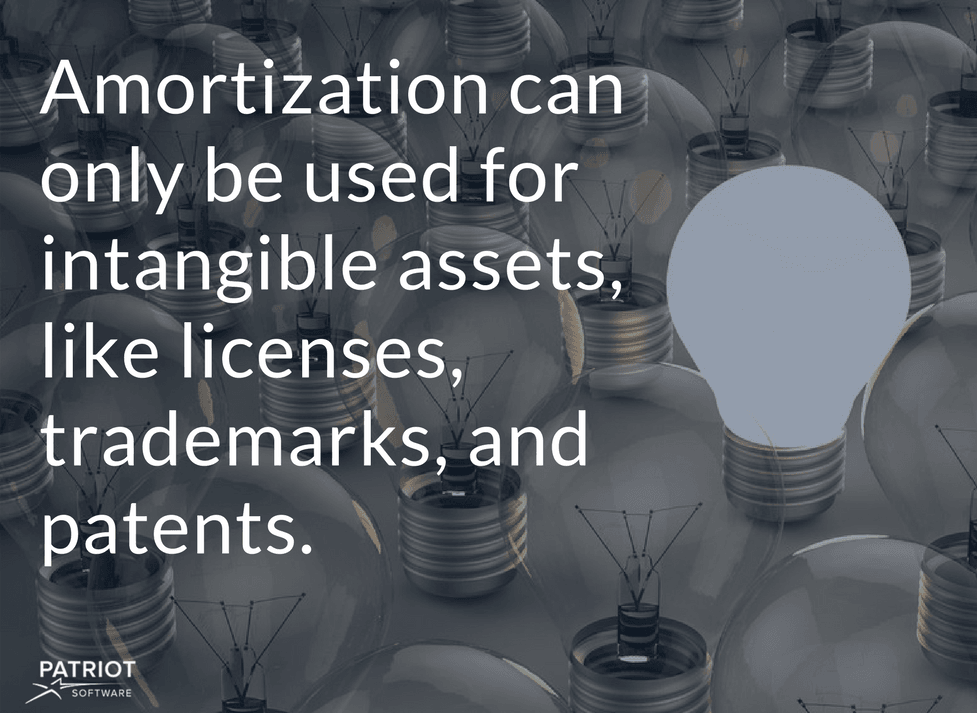To protect your business and operate under the law, you might obtain licenses, trademarks, patents, and other intangible assets. These items can be costly to a small business. You can use amortization to reduce your taxable income throughout the life of intangible assets. What is amortization?
Amortization definition:
In accounting, the amortization of intangible assets refers to distributing the cost of an intangible asset over time. You pay installments using a fixed amortization schedule throughout a designated period. And, you record the portions of the cost as amortization expenses in your books. Amortization reduces your taxable income throughout an asset’s lifespan.
What can be amortized?
You can only use amortization for certain business purchases. Which assets are amortized?
Only intangible assets can be amortized. Intangible assets are items that do not have a physical presence but add value to your business. For example, you can amortize trademarks.
Amortizing lets you write off the cost of an item over the duration of the asset’s estimated useful life. If an intangible asset has an indefinite lifespan, it cannot be amortized (e.g., goodwill).

How amortization works
Most assets lose value over time. Amortization lets you quantify gradual losses in your accounting records. You show the decrease in an asset’s book value, which can help you reduce your taxable income.
When an asset brings in money for more than one year, you want to write off the cost over a longer time period. Use amortization to match an asset’s expense to the amount of revenue it generates each year.
Amortization also refers to the repayment of a loan principal over the loan period. In this case, amortization means dividing the loan amount into payments until it is paid off. You record each payment as an expense, not the entire cost of the loan at once.
Amortization journal entry
You must record all amortization expenses in your accounting books. To record an amortization journal entry, find:
- The initial value of the asset
- The lifespan of the asset
- The residual value of the asset
1. Identify the asset’s initial value. For intangible assets, knowing the exact starting cost isn’t always easy. You may need a small business accountant or legal professional to help you.
2. Estimate the asset’s lifespan. How long will you use the asset? For example, different kinds of patents have various lifespans. A design patent has a 14-year lifespan from the date it is granted. If you patent a design, you will amortize it over 14 years.
3. Find the asset’s residual value. Residual value is the amount the asset will be worth after you’re done using it. As an asset ages, its value decreases. The item might not have any value once its lifespan is complete.
How to calculate amortization expense
With the above information, use the amortization expense formula to find the journal entry amount.
(Initial value – residual value) / lifespan = amortization expense
Subtract the residual value of the asset from its original value. Divide that number by the asset’s lifespan. The result is the amount you can amortize each year. If the asset has no residual value, simply divide the initial value by the lifespan.
Record amortization expenses on the income statement under a line item called “depreciation and amortization.” Debit the amortization expense to increase the asset account and reduce revenue. Credit the intangible asset for the value of the expense.
Amortization example
Amortization is important for managing intangible items and loan principals. Take a look at the following amortization examples.
Amortizing an intangible asset
You own a patent on a machine, and that patent lasts 20 years. You spent $20,000 to design and create the machine (initial cost of the patent). You should record $1,000 each year as an amortization expense for the patent ($20,000 / 20 years).
Amortizing a loan
You have a $5,000 loan outstanding. If you pay $1,000 of the principal every year, $1,000 of the loan has amortized each year. You should record $1,000 each year in your books as an amortization expense.
What is the difference between depreciation and amortization?
Amortization is similar to depreciation. Depreciation is used to spread the cost of long-term assets out over their lifespans. Like amortization, you can write off an expense over a longer time period to reduce your taxable income. However, there is a key difference in amortization vs. depreciation.
The difference between amortization and depreciation is that depreciation is used on tangible assets. Tangible assets are physical items that can be seen and touched. For example, vehicles, buildings, and equipment are tangible assets that you can depreciate.
You must use depreciation to allocate the cost of tangible items over time. You cannot amortize a tangible asset. Likewise, you must use amortization to spread the cost of an intangible asset out in your books.
Need a simple way to keep track of your small business expenses? Patriot’s online accounting software is easy-to-use and made for the non-accountant. We offer free, U.S.-based support. Try it for free today.
